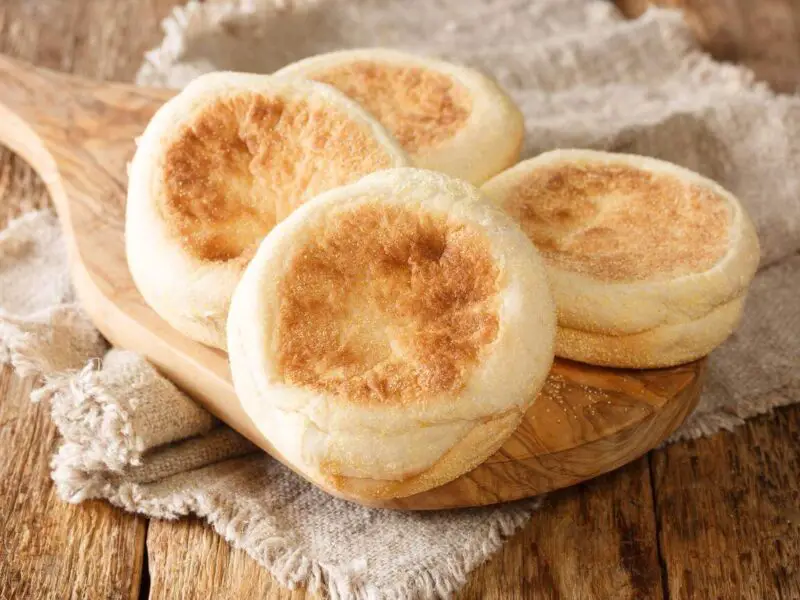Good morning muffin lovers! For those of you who are anything like me, you’ve likely found yourself with a surfeit of English muffins more times than you can count. They seem to multiply in my pantry regardless of how few I bring home from the store. And once the package is open, it’s hard to resist their nooks and crannies begging to be filled.
It was on one such day of muffin misery that the proverbial lightbulb switched on above my head. As I watched yet another batch meet its demise in the trash, I wondered – can you freeze english muffins to prolong their lifespan? With a little research, I discovered not only could they be frozen, but it was downright genius in terms of maximizing the muffiny goodness!
Today, I’m here to share my newfound muffin freezing wisdom with all of you fellow hoarders out there struggling with the same dilemma. Read on for all the tips and tricks I’ve learned to make freezing English muffins a breeze. I promise your mornings will never be the same…in a very delicious way.
Can You Freeze English Muffins?
This was obviously the burning question I needed answered before starting on my muffin freezing journey. Through some internet sleuthing, I was thrilled to find resounding confirmation that yes – English muffins can indeed be frozen!
While the idea may seem counterintuitive for something as airy and delicate as a muffin, freezing properly sealed muffins allows them to maintain their texture and taste buds appeal for up to 12 months. All those leftovers I never knew what to do with could be preserved for nearly a whole year, just waiting to be toasted back to breakfast glory.
But how exactly do you freeze a muffin without ending up with soggy, flavorless rocks? That’s where the proper techniques come in. Things like wrapping, storage methods, thawing instructions – these all play a crucial role in freezing baked goods. If not done right, muffins are doomed to be disappointing.
Through my experimentation, I discovered the key is creating an airtight seal to prevent moisture loss. Things have to be sealed up tight since freezing essentially pops any trapped air bubbles that help baked items retain their structure. If air can still permeate thewrappers, muffins won’t come out as fluffy after thawing.
Wrapping English Muffins for Freezing
Now that you know freezing muffins is indeed a viable solution, let’s dive into the all-important wrapping process. As I mentioned, this step is key for maintaining muffin freshness and avoiding negative texture changes later on.
My go-to materials are plastic food wraps and foil. Both cling smoothly and provide a strong, airtight barrier. Lay a single muffin flat and center a large sheet of the wrap or foil directly over top. Then, gather up the edges tightly and begin rolling the muffin inwards.
As you roll, squeeze out any excess air pockets between the muffin crumb and wrapping. The goal is to remove all airspace that could cause drying during freezing. Keep rolling until the entire muffin circumference is thoroughly enclosed in a tight, wrinkle-free covering.
I’ve experimented with parchment paper and reusable wraps made of silicone or beeswax as well. But ultimately, plastic or foil simply work best at forming an impenetrable moisture seal. Plus they’re budget-friendly materials most kitchens already have on hand.
Once rolled, give the packet a light squeeze all over to check for air gaps. If you feel any giving, there may be crevices that need additional wrapping turns for full coverage. Airtight is absolutely key to frozen muffin success.
With practice, this process only takes a minute or less per muffin. And definitely less time than it would take each morning to run to the store for a fresh batch! Trust me, the slight effort upfront saves tons of time and hassle baking or shopping later on.
Freezer-Safe Storage Bags
After they’ve been individually wrapped, it’s time to bag up the muffins for the freezer. Again, proper storage containers are crucial at this stage. You’ll want heavy-duty bags made specifically for freezing temperatures.
Look for the term “freezer” bags that are rated for keeping contents fresh down to 0°F. These thicker pouches provide optimal insulation from frost and ice formation inside. Thinner store brands just aren’t heavy-duty enough.
Personally, I like reusable zip-top freezer bags. Not only are they sturdier and last for many freezer cycles, but the sealable closure keeps muffins fresher longer without dryness. The flat lay style also allows me to maximize valuable freezer real estate.
Once wrapped muffins are securely inside high-quality freezer bags, press out any remaining trapped air and seal tightly. Make sure to label with contents and packaging date too. This step only takes a minute and pays big dividends in organization later on!
Proper sealing throughout the wrapping and bagging process creates an impenetrable barrier against freezer burn and staling. Your muffins will stay as soft and springy as the day they went into the deep freeze, ready when a breakfast craving strikes.
Whole or Sliced? Freezing Muffins
After wrestling with mountains of muffins, one question plagued me – to slice or not to slice before freezing? Would horizontal halves hold up differently than whole muffins come thaw time?
My scientific method involved wrapping and freezing four test batches: two whole, two sliced in half. A few weeks later, I did a blind taste test with fresh, never-frozen muffins as a control group.
To my surprise, there was essentially zero difference between whole and sliced versions! Both held their soft, fluffy textures beautifully whether toasted or microwaved. Flavor and moisture levels remained on par with fresh-baked too.
For me personally, whole muffins are slightly simpler since there’s no prep step of slicing. But halves take up less space in bags and make for easy grab-and-go breakfast sandwich builds. So in the end, it really comes down to your own routine!
The takeaway is that either method works great. Don’t stress over slicing – go with whichever fits your workflow and storage containers best. Freezing alleviates that dreaded staleness regardless.
How Long Do Frozen English Muffins Last?
So by now you’ve mastered the proper wrapping and storage techniques, but how long can you actually keep muffins frozen for?
According to all the research I’ve done, the average freezer shelf life for sealed English muffins is around 12 months. However, some variables like specific freezer temperature can slightly adjust that timeframe.
To help ensure maximum freshness, I like to label my bags with freeze dates. Then every few months, I’ll take inventory and use the oldest batches first. Signs like discoloration, ice crystals or stale texture after thawing indicate it’s time for replacement.
If properly enclosed with no oxygen exposure, I’ve found muffins maintain ideal density and softness up until that 12 month mark. Beyond which, dryness or flavor fade may gradually set in.
Of course, trust your senses too – if a batch seems at all suspect in terms of appearance or flakiness, it’s best not to risk eating it. Safety first!
Thawing Frozen English Muffins
Since muffins freeze so well, thawing is made simple too with no need for advance planning. Here are the quickest methods I recommend:
Toaster – For the ideal crispy-outside, soft-inside experience, directly insert frozen muffins. Toasting brings them back to life while you get ready.
Microwave – Wrap each muffin loosely in a paper towel and microwave in short 30 second bursts until no longer icy. Rotate for even heating.
Counter top – Leave muffins wrapped on the counter to slowly thaw at room temp over 1-2 hours. Flip occasionally for uniform thawing.
Direct use – Assembling to-go sandwiches? Pop frozen muffins onto dishes – they’ll thaw during your commute or sitting time.
Baking – For muffins destined for the oven, thaw wrapped on a rimmed baking sheet in a 300°F oven. Times vary but start checking at 15 minutes.
Additional Muffin Storage and Usage Tips
Now that you’re well-versed in proper muffin freezing, let me share a few additional tips to maximize their potential:
Refrigeration – If you’ve only got a week or two’s worth in the freezer, restocking fresh muffins can go straight into the fridge compartment for 3-4 days of freshness.
Avoid refreezing – For best texture, don’t refreeze muffins that have already fully thawed. The repeated temperature changes cause dryness.
Portion control – When reheating a batch, portion leftovers into single-serve sandwich bags or containers before putting any excess back in the freezer.
Reheating – Thawed muffins can be crisped in a 325°F oven for 5-7 minutes until warm and lightly golden. Watch closely to avoid burning.
Get creative – Break out of your toast rut! Stuff muffin halves with fillings like eggs, avocado, nut butters for an easy meal. Or layer with sauces for sliders.
FAQs about Freezing English Muffins
Now that you’ve got the basics down, here are answers to some additional frequently asked questions:
Can I freeze muffins with butter/jam already on them?
It’s best to avoid pre-spreading so the fillings don’t make the muffins soggy during freezing and thawing. Spread toppings after reheating for freshest flavor.
How do I prevent freezer burn?
Proper wrapping and sealing is key – no exposed muffin edges! Also using freezer-rated storage bags and placing in coldest part of freezer (usually back corner) limits moisture loss.
Can you freeze muffins you want to use for savory dishes?
Absolutely! Whether making classic breakfast sandwiches or muffin pizzas/sliders, savory muffins freeze just as well as sweet. Just be mindful of condiments mellowing flavors over time in freezer.
How long do partially used bags of muffins last in the freezer?
As long as remaining muffins are tightly wrapped, a bag can stay fresh in the freezer for 4-6 weeks once opened. Portion leftovers promptly into sealed containers or bags after each use for optimal freshness.
Can gluten-free muffins be frozen?
Yes, gluten-free varieties hold up equally well to freezing techniques. Just be sure to thoroughly seal against air pockets which is even more important for delicate gluten-free baked goods.
Can I add flavors like cinnamon or raisins before freezing?
Adding mix-ins prior to freezing is fine as long as they don’t cause sogginess or leakage during storage and reheating. Finer mix-ins like cinnamon tend to do better than coarser ones like raisins, which could make the texture mealy over time. Another option is sprinkling mix-ins on top after muffins have thawed and are ready to toast.
Do you have to thaw muffins all the way before reheating?
Nope! As long as they are not completely solid, muffins can go directly from freezer to toaster or oven for reheating. The applied heat will easily finish the thawing process. Just keep a close eye to avoid burning partially frozen bits. An extra minute or two may be needed compared to fully thawed muffins.
Is the method different for freezing muffins from a bakery versus homemade?
The freezing process is essentially the same regardless of where the muffins originated. However, muffins from a bakery may contain additional preservatives that extend their freezer shelf life even longer than 12 months in some cases. Homemade muffins without preservatives are still perfectly safe to freeze for up to a year with proper storage and handling.
Can muffin tops be frozen on their own?
Yes, muffin tops freeze just as well! Wrap individually and place in freezer bags. Their smaller, flatter shape allows for easy stacking to maximize space. Just be sure to securely seal the crumbly tops against damage. Thaw and warm tops same as full muffins before serving.
I hope these FAQs provided some additional value! Let me know if any other muffiny questions come up. I’m always here with ideas to help you make the most of your stash.
Conclusion
Okay readers, I hope you’ve enjoyed learning all the ins and outs of freezing English muffins! To wrap things up, here are the key takeaways:
- Yes, English muffins absolutely freeze beautifully for up to 12 months when sealed properly in heavy-duty freezer bags.
- Wrapping each muffin tightly in plastic wrap or foil before bagging is essential to preventing dryness and staling in the freezer.
- It doesn’t matter if you freeze muffins whole or sliced – both methods retain soft texture equally well after thawing.
- Thawing is made simple through quick methods like toasting, microwaving or counter-top resting. No need for advance prep.
- Follow basic freezer storage dos and don’ts like labeling, first-in-first-out rotation, and avoiding refreezing previously thawed muffins.
I hope the techniques I’ve tested and tweaked provide you a foolproof solution for enjoying fresh muffins all year long. Please feel free to reach out if you have any other questions! I’m always brainstorming new muffiny recipes and tips to share.
In the meantime, happy freezing – and don’t forget to drop those muffin-inspired creations in the comments. Who knows, they may inspire a future blog installment! Wishing you all muffiny goodness.



